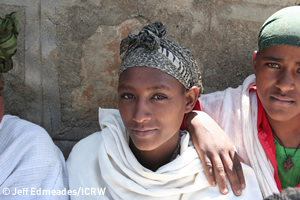
A poignant reminder
Media Contact
As a researcher, it is sometimes very easy to focus on the forest and lose sight of the trees. We become so engrossed in the mechanics of research, worrying about things like sample size, response bias and quality control that at times it is easy to momentarily forget about the actual people our research strives to help.
I was recently reminded of this while in Ethiopia’s Amhara region for an ICRW and CARE-Ethiopia project that aims to improve the lives of girls who became wives and mothers before they ever had a chance to live out their childhoods. I have been working on this project for almost two years, and have had the privilege of talking to lots of child brides. Sadly, their stories are all quite similar.

“How old were you when you got married?” I asked them. Each quietly said a number – 14, 9, 16.
“And how old was your husband?”
Twenty-two. Eighteen. Thirty.
“Did you know your husband before you met him at the marriage ceremony?”
Most did not, they told me, though some of them did, but usually not well.
“What was the process of marriage like for you?” I asked, knowing that in Amhara marriage is made up of several steps.
Speaking over each other, they filled me in on what’s involved: “Well, first you are promised to marriage by your parents, then you have a ceremony, then you start living with his family part-time, then full-time and then you sleep together…”
“Who decides when it is time to sleep together and how do they know it is time?”
Laughing shyly, the girls told me that for most the decision is made based on physical changes during puberty. None had chosen when to start having sex; their husband or in-laws decided for them.
“How old are girls at that time usually?”
Most answered “14, 15, 16,” but a handful said 10 years old, which is almost certainly before many girls started puberty given their poor diets.
I explained that in the U.S., girls usually live very different lives. Virtually no girls their age would be married already and very, very few would have children. Most girls would be in school and wouldn’t be thinking of marriage until they finished with university.
And then it was my turn.
When I told them that my wife was older than me – by a mere eight months – there was an audible gasp of surprise and then the girls started laughing. In Amhara wives are on average eight years younger than their husbands. Most of the girls guessed that I was ten to 17 years older than my wife.
They were particularly impressed by how long women in the U.S. waited to have children, even after marriage, and that many are able to continue their education until they want to stop – something several girls expressed regret at not being able to do.
More than anything, our conversation highlighted the ways in which the girls’ life horizons had been narrowed by poverty, the rural nature of their setting and early marriage, which robbed them of the opportunity to finish school or have any experiences beyond that of being a mother and wife.
As we talked to each other about our lives, I realized that I had been in the forest too much; at some point I had started to think of these girls as a large, homogenous group rather than the individuals that they clearly were. Chatting with them that day was an important and poignant reminder of the human impact of early marriage, and that each girl has her own strengths, her own dreams.
The purpose of our work, I was reminded, is not so much about the sample size or response bias, as is about helping these young wives and mothers reach their full potential.
Related blogs from Ethiopia:

